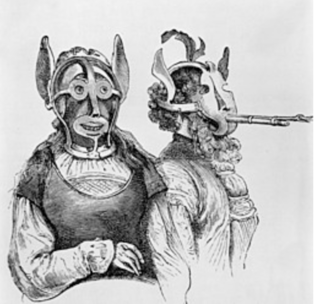Gender
Why Do We Think Women Talk Too Much?
The fascinating history behind the damaging stereotype.
Posted July 12, 2020 Reviewed by Abigail Fagan
Women have long been painted as the overtalkative and gossipy sex. Just consider the vast number of proverbs about women’s tongues ("A woman’s tongue wags like a lamb’s tail, never still," and "Many women, many words"). Or the fact that we seem to need a doll called Chatty Cathy, but lack a doll like Conversant Ken. Perhaps Barbie would have found him much less attractive if he tried to be more than just a macho sidekick.
But a quiet Ken is no surprise. Literature and popular culture tell us to expect strong silent types to be named Tom, rather than Tiffany. And that boys settle things with fists rather than tongues, while girls use language as a weapon to take down other girls, the linguistic equivalent of speech samurais.
But where did this pervasive ideology about the speaking styles of men, women, girls, and boys come from? And why does it persevere despite research that suggests this depiction of women’s talk is far from accurate?
Well, as my students would say, because reasons. And, it turns out, a long history of ideological priming. So, why not go back to the beginning?
The idle chatter of women and the important talk of men
The association of women with idle and potentially even dangerous talk stretches back as far as early Greek and Roman philosophers, whose writings often valorized men and decried the comparative weaknesses of women. In History of Animals, for instance, Aristotle suggests women speak falsely and are more apt toward complaining.
The temptation here to draw a comparison to the modern ways of women may be hard to resist, but, please do. This impulse is just an example of how deeply entrenched the myths surrounding women’s talk are.
It has long been held that women’s voices did not belong in public spheres. Writing in antiquity, Greek essayist Plutarch suggested that a famed statue of Aphrodite’s tortoise served to illustrate that a woman’s primary role was in the home and to keep silent when outside of it. Impressive as it is that he could get all that from a statue of a tortoise, he was far from alone in this widespread belief that public speaking should be the domain of men in the ancient world.
As linguist Jennifer Coates discusses in her book Women, Men and Language, women were heralded as moral and virtuous, and those adhering to dominant social structure valued. Virtuous women, according to Aristotle, should not be involved in public affairs.
Those who disrupt the social order (by talking out of turn or on subjects outside the domestic realm) were viewed with contempt and defined as acting outside the confines of femininity. For example, Roman Consul Cato the Elder chastised matrons who had the gall to address other women’s husbands with their concerns. In other words, bother your own husbands, but please don’t bother anybody else’s.
Women’s talk through the Middle Ages
This tradition of treating women’s public talk as untrustworthy and morally questionable continued in religious texts in the 12th and 13th centuries, where clerical writings warned of the danger of women’s false tongues. Indeed, the term old wives' tale dates back to early warnings of women’s tendency to tell immoral false tales.
Fast forward a century or two and we begin to see the very real consequences that face women’s voices in domains outside the domestic. In a book examining the intersection of public talk, gender, and class during the medieval period, Sandra Bardsley explores how, after the Black Death, opportunities for the peasant class grew as the massive death toll in Europe created an economic and social void.
But this gain in status also engendered increasing political unrest as the lower classes began to raise their voices against the highly inequitable system of local governance and taxation. Women who gave voice to concerns and aired grievances in semi-public spheres such as the market or spinning circles became viewed as potentially disruptive to the social order.
Particularly in a much more oral society than we have today, such talk was viewed as potentially inflammatory or dangerous. Word of mouth was essentially the internet of the Middle Ages. As a result, it was increasingly criminalized and prosecuted in what became known as "Sins of the Tongue." In effect, the levying of these charges cast shame on those accused and became a very effective form of social control.

Reviewing magistrate records from this period, Bardsley found that women made up the majority of such prosecutions for "scolding" and defamation. The idea of a scold is very much a gendered one, and one which underpinned many later negative literary images of the disorderly loquacious female, such as Shakespeare’s shrew and the fishwife.
As well, the type of talk most often viewed contemptuously is precisely what we call "gossip," and has overwhelmingly remained associated with the talk of women, a legacy of the characterization of the trivial and disparaging nature of women’s talk throughout history.
Even the word "gossip" itself only took on a pejorative sense once it became associated strongly with the talk of women. Originally, the word gossip came from "god sib" literally meaning "god parent" and was used to describe those who gathered for a christening. Over time, it came to refer only to women at such events and then more generally to any gathering of women friends. It was at this point the term started to semantically deteriorate to refer to slanderous talk, associated with women.
As we move into the 18th and 19th century, we have this backdrop of the demonizing of women’s words in public spheres, alongside growing notions of standards and purity. Women of good standing were expected to be exemplars of pure and standard speech, but were often faulted with insufficiencies and weak language in texts from the time, such as Samuel Johnson’s dictionary and, as Coates explores, letters to the popular 18th-century publication The World. Etiquette books from the era valorize the quiet and respectful woman while cautioning against the loud and shrill one.
Women’s talk in the modern age
It is from this background that we arrive at the era of modern speech. Women’s voices outside domestic domains such as workplaces and courtrooms still face difficulties being heard, especially in male-dominated industries.
Adopting what has been referred to as a male style of speech, on the other hand, is also often subject to censure, as discussed in research on unfavorable reactions to Hilary Clinton’s speech style by communication studies professor Karlyn Campbell.
It would appear that we still hold dearly to the idea that women remain the great trivializers of talk, and that speech in the public domain is best left to men. For instance, well-known research by education scholars Myra and David Sadker and Nancy Zittleman found that boys take up the majority of class talking time. Similarly, women have been found to contribute less in professional settings, where men tend to control the conversational floor.
Yet ask most people which is the most talkative sex, and they will doubtless offer up women. Teachers in those same studies that found more talking time for boys reported feeling that girls took up more of their time in class. In reality, they actually gave more attention to boys by calling on them frequently while they interrupted girls’ talk more. Early then begins the long process of disempowering girls by treating their talk as marginal and unwelcome.
This suggests that our long-held beliefs about women’s speech create subtle but very real obstacles to women’s contribution to and success in professional, institutional, and educational arenas. Linguist Deborah Tannen, who has studied gender and workplace language, suggests that women are more reticent to talk or self-promote when in contexts typically dominated by men.
This, of course, may impact their competitiveness for promotions and leadership positions by those higher up, though it is not clear that women speaking up would be received well. Research by psychologist Victoria Brescoll looking at the distribution of talk by gender shows that institutional power encourages men but discourages women from talking more, as powerful women fear a backlash that is absent for men when taking on a greater share of the conversational floor.
So, as employers, as parents and as spouses, we owe it to our daughters, our wives, and our female colleagues to give them room to speak and to take time to listen to what they say, resisting our socio-historically indoctrinated impulse that women don’t have much to contribute.
Though entrenched deeply in our history, stereotypes of women’s talk are not only far from accurate, but also come at quite a cost. With the growing number of women in positions of power economically and politically, we now have the opportunity to incorporate their voices and understand the value of all talk to a degree we never have before.
Facebook/LinkedIn image: fizkes/Shutterstock
References
Baum, Armin. 2014. Paul’s Conflicting Statements on Female Public Speaking and Silence. Tyndale Bulletin 65.2. 247-274
Bardsley, Sandra. 2006. Venomous Tongues: Speech and Gender in Late Medieval England. University of Pennsylvania Press.
Brescoll, V. L. 2011. Who Takes the Floor and Why: Gender, Power, and Volubility in Organizations. Administrative Science Quarterly, 56(4), 622–641.
Campbell, Karlyn Kohrs. 1998. The Discursive Performance of Femininity: Hating Hillary. Rhetoric and Public Affairs, vol. 1, no. 1. pp. 1–19.
Coates, J. 2016. Women, Men and Language. London: Routledge
Tannen, Deborah. The power of talk: Who gets heard and why. Harvard Business Review. https://hbr.org/1995/09/the-power-of-talk-who-gets-heard-and-why
Sadker, D., & Sadker, M. 2009. Still failing at fairness: How gender bias cheats girls and boys in school and what we can do about it. New York: Scribner




